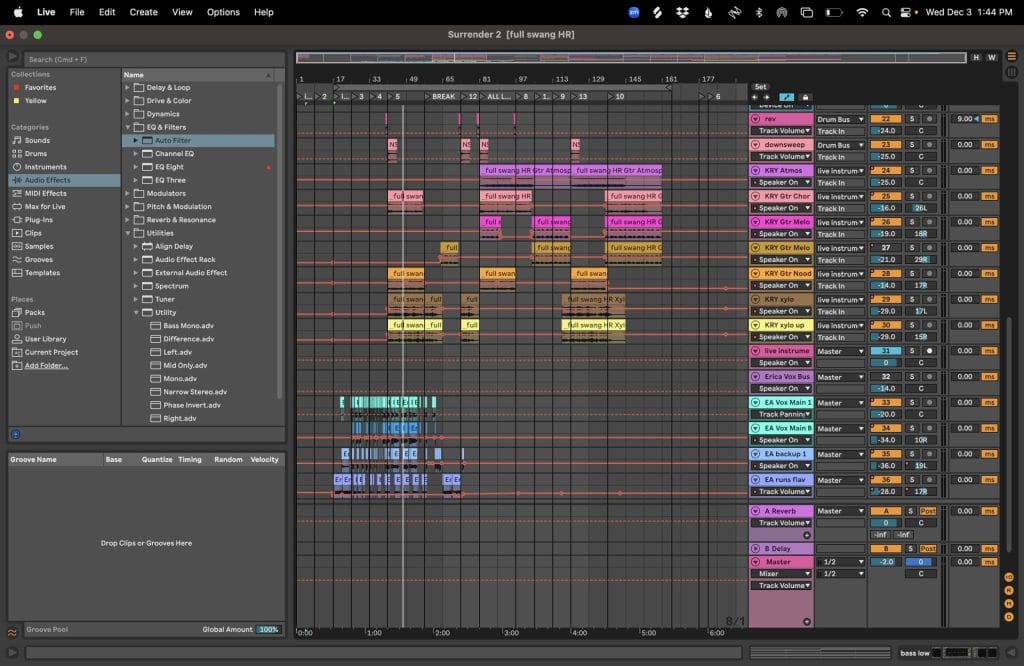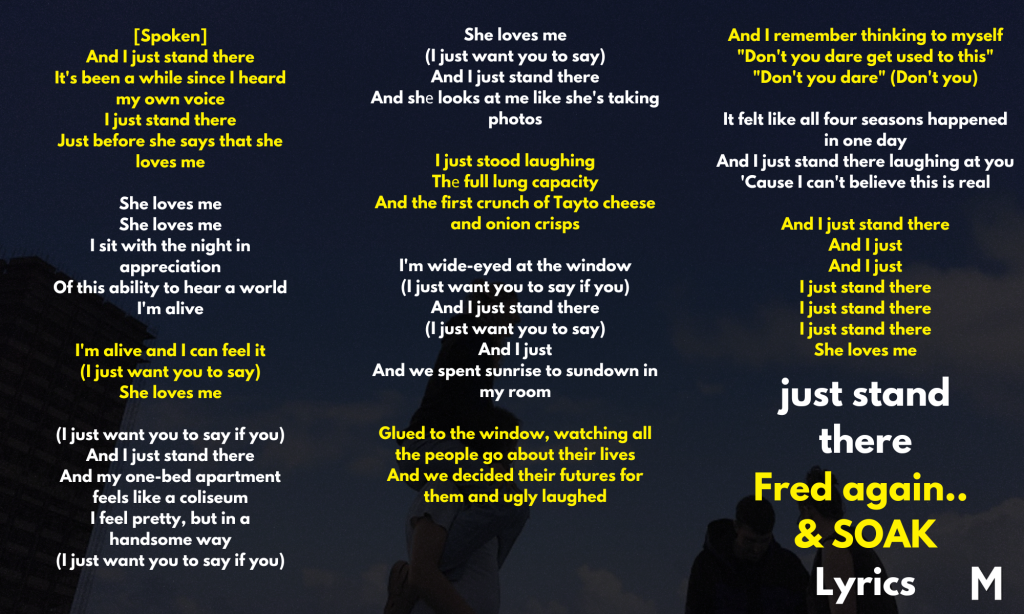Table of Contents
Image Courtesy Of Atlantic Records
Fred Again.. has risen to stardom quickly due to his unique production style, which often blends poetically focused spoken word samples with a lo-fi, intimate quality, alongside his maestro-level skills in the studio. With the release of his latest album and a series of heart-wrenching, intimate, and masterfully produced singles, the sheer volume of quality he’s delivering is remarkable. His latest single, “Just Stand There,” stands out as one of his more lyric-heavy tracks, offering a lot to unpack for those who take the time to connect the dots.
Pre-Order The Ten Days Vinyl Here And Follow Our Smart Pop Playlist Below
It’s impossible to separate the lyrics from the music with Fred Again. With a background in English literature and over a decade of experience in music production, I feel that maybe I can bring a fresh perspective to the exploration of how the lyrics and production in “just stand there” work together to create a deeper meaning, one that transcends the sum of its parts.
Through this exploration, I discovered some fascinating connections between authenticity and the disconnect of digitalism, the raw emotional power of the human experience, and the ethereal quality of his production. Let’s start with the lyrics before delving into the deeper meaning behind Fred Again’s latest single, “Just Stand There,” which was made in collaboration with SOAK.
Fred Again.. Just Stand There Lyrics
Fred Again.. Just Stand There Meaning
“She loves me”
The song begins with the repeated phrase “She loves me,” delivered in isolation.
This line sets the stage for the entire track and continues to be an anchor-like motif by introducing the theme of love in its most unadorned and vulnerable form. The starkness of the opening, devoid of any musical accompaniment, mirrors the raw and unfiltered nature of the sentiment. The absence of foley, textures, or musical elements highlights the speaker’s introspection as if they are standing alone with their thoughts, reflecting on the simple yet profound realization of being loved.
This bare introduction lulls the listener into a sense of calm, which is soon disrupted as the track subtly begins to introduce the main progression progression which introduces the second half of the dichotomy that makes this track so magical: one of authentic realism and digital dreamlessness as the transients and initial hits of the chord progression make you think it will be a Rhodes keyboard or something similar until mere moments later the portamento on the sound belies its digital nature.
The song’s blatant use of modern production techniques underpins a vocal line that is as real and vulnerable as it gets. This line is the through line that all of the following sections revisit, each time merging together what is real and unreal.
“And I just stand there / It’s been a while since I heard my own voice”
As the track progresses, the speaker’s introspection deepens.
The line “And I just stand there” captures a moment of stillness, where the speaker is caught between the emotion’s simplicity and its implications’ complexity. The absence of strong emotional delivery in the spoken word vocals emphasizes this stillness, making the moment feel almost surreal, as if time has paused for the speaker to absorb the gravity of the situation fully.
The introduction of filtered, distorted counter-melodies in the vocal section around the 50-second mark adds tension to this stillness and is the first taste of the digital nature of production that the vocal layers sees (but it’s far from the last). These background elements, though subtle, create a disjointed feeling, contrasting the raw, dry lead vocals with the increasingly complex and hyper-digitalized production. This tension reflects the internal conflict of the speaker—while they outwardly project calmness, there is an undercurrent of unease and anxiety, as if they are bracing for something yet to come.
“And my one-bed apartment feels like a coliseum”
This line introduces a shift in the imagery, where the speaker’s modest surroundings take on an exaggerated, almost grandiose quality. The apartment, a symbol of personal space and intimacy, transforms into a “coliseum,” a place of spectacle and combat. This metaphor could represent the internal battle the speaker faces as they navigate their feelings of love and vulnerability.
The introduction of drums, heavily filtered to create an underwater effect, begins to build momentum in the track. This rhythmic foundation of filtered percussions, reminiscent of Noah “40” Shebib’s production style, gives structure to the previously freeform vocals and synths. The tension between the calm vocals and the increasingly pronounced rhythm section mirrors the speaker’s struggle to maintain composure while dealing with the overwhelming nature of their emotions.
“I sit with the night in appreciation / Of this ability to hear a world”
Here, the lyrics take on a more contemplative tone.
The speaker’s awareness of their surroundings—both internal and external—heightens, as they appreciate the simple act of being alive and present in the moment. This introspection is mirrored by the introduction of a heavily staccato, tremoloed piano around the 1:40 mark. The rapid 1/16th note patterns with a heavy swing on them played by the piano inject a sense of urgency and anxiety into the track, creating a sharp contrast with the serene vocals.
The piano’s anxious energy, combined with the calm vocal delivery, underscores the theme of internal conflict. The speaker’s calm exterior belies the turmoil brewing beneath the surface, much like the track’s tranquil beginning gives way to a more complex and layered soundscape which you can watch him perform live in a recent Instagram post.
“And we spent sunrise to sundown in my room”
The line “And we spent sunrise to sundown in my room” draws us into a moment of closeness, where time seems to stretch endlessly within the confines of a single room. It’s intimate, almost nostalgic, yet there’s a lingering tension as the speaker warns themselves, “Don’t you dare get used to this.” That caution hints at the temporary nature of this connection, a fleeting day that’s as precious as it is fragile.
Musically, this tension is reflected in the extended chord progression, which spans 16 bars or more. The progression’s length creates a space where emotions can simmer and build, mirroring the speaker’s growing awareness that this moment, however perfect, isn’t built to last. The lo-fi production—full of white noise and static—adds a raw texture that keeps the track grounded, preventing it from becoming overly polished or predictable. It’s a subtle reminder that even in moments of deep connection, there’s always an undercurrent of uncertainty.
This scene taps into the symbolic power of sunsets and transitions, much like how literature often uses these natural shifts to signal changes in relationships or states of mind. The song encapsulates that bittersweet tension between connection and impermanence, capturing how we often find ourselves clinging to the present while knowing it’s bound to slip away.
“It felt like all four seasons happened in one day”
The line “It felt like all four seasons happened in one day” captures the overwhelming and rapid shifts in the speaker’s emotions. Each season symbolizes a different phase, from the warmth of love to the coldness of despair, reflecting the intensity of the speaker’s inner turmoil. This imagery highlights how quickly emotions can change, much like the unpredictability of weather.
The song’s production complements this theme by gradually becoming more complex, incorporating heavy glitches and modern techniques that mirror the emotional chaos described in an even more heavy-handed manner than in the opening few sections, as the reiteration of themes reinforces its meaning and importance. The progression towards a more hyper-digitalized sound creates a dreamlike atmosphere, aligning with the speaker’s surreal experience.
Despite the increasing intensity, the vocals maintain a serene quality, providing a stark contrast to the turbulent emotions and preserving the track’s ethereal undertone.
In literature, the four seasons are often used to symbolize different stages of life or emotional states spring brings renewal, summer heats up with intensity, autumn signals change, and winter marks endings. This song taps into that symbolism, using the line about “all four seasons” to convey the whirlwind of emotions the speaker goes through in a single day. It’s a clever way of grounding the listener in something familiar while amplifying the emotional weight of the track. The seamless blend of lyrical metaphor and evolving production pulls you deeper into the experience in a way that no other art medium could (it is the message, after all).
“And I just stand there laughing at you / ‘Cause I can’t believe this is real”
In these lines, the speaker expresses disbelief at the reality of their situation. The laughter is not one of joy, but rather a nervous, almost incredulous reaction to the overwhelming nature of their emotions. The track’s production reflects this disbelief as the once calm and serene soundscape becomes increasingly chaotic and complex.
Fred’s musicianship shines through in the subtle shifts and nuanced effects that build tension without relying on typical EDM tropes like white noises and pitched risers that even he leans into heavily on some of his more club-friendly records. The chord progressions, vocals, and the very texture of the record itself provide enough rising tension and forward motion to keep the track’s momentum driving forward and create a sense of progression and evolution.
“She loves me”
The track concludes by returning to the phrase “She loves me,” bringing the song full circle.
However, the repetition of this line now carries new weight and complexity, reflecting the journey the speaker has undergone throughout the track. The calmness of the vocals, set against the increasingly digital and chaotic backdrop, suggests that the speaker has found a sense of peace amidst the turmoil.
The main takeaways here for me that I had while listening is that it’s undoubtedly a masterclass in balancing simplicity with complexity as much as it does authenticity with the almost disconnected quality of heavy-handed modern productions. The calm, serene vocals anchor the track, providing a sense of continuity and emotional stability, while the evolving instrumental backdrop adds layers of tension and depth. The production choices, from the subtle introduction of lo-fi elements to the gradual build-up of hyper-digitalized textures, reinforce the themes of love, vulnerability, internal conflict, and the unsettling etherealness of remembering the past (which was reinforced through the disjointed and ethereal qualities of the blatant production moves Fred is best known for).
The post Fred Again.. Just Stand There Lyrics And Meaning: Merging Words And Music To Find A Deeper Message appeared first on Magnetic Magazine.






